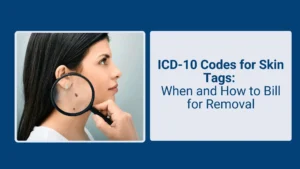Interestingly, you should know that…
Allergic rhinitis affects more than 20 million Americans annually, which makes it one of the most prevalent chronic conditions observed in an outpatient environment. This condition can be caused by pollen, dust mites, or pet dander, and millions of people make healthcare visits and insurance claims because of it.
However, it would come as a shock that so many of those claims are rejected or held up because of inappropriate coding.
This is why it is not merely the application of good clinical practice to learn the right use of the ICD-10-CM code for allergic rhinitis (J30.9), but it is mandatory for the financial accuracy and the revenue cycle. And that is exactly what we are going to do in this guide, brought to you by Providers Care Billing LLC, a company you can trust when it comes to medical billing services.
What Is ICD-10 Code J30.9?
ICD-10 code J30.9 is used to characterize allergic rhinitis, unspecified. This code will be applied when a patient has arrived with certain symptoms which can be related to allergic rhinitis (e.g., sneezing, nasal congestion, itchy eyes); nevertheless, the allergen or seasonality has not been identified yet.
Code Overview:
- ICD-10: J30.9
- Description: Unspecified allergic rhinitis
- ID: Diseases of the respiratory system (J00 J99)
- Type: chargeable/specific code
- Use Case: Whereby the prompt allergen is not ascertained or not recorded
This code is classified under a wider spectrum of rhinitis codes of the ICD-10 set of codes, having particular forms such as seasonal allergic rhinitis, food-induced allergic rhinitis, and pollen-induced allergic rhinitis.
When Should You Use J30.9?
Use J30.9 when:
- The patient demonstrates general signs of allergic rhinitis, which include sneezing, itching of the nose or eyes, congestion, or nasal streaming
- The agent (e.g., pollen, pet dander, mold) is either not recorded or not known
- It is chronic or recurrent and is not an acute condition
- This code works perfectly well in the first evaluation or in cases where testing has not been carried out.
Common Symptoms Supporting J30.9 (Allergic Rhinitis Unspecified ICD-10 Code)
Clinical signs favoring the use of J30.9 should be well documented. These include:
- Sneezing (see also sneezing ICD 10: R06.7)
- Discharge of nasal congestion and rhinorrhea (runny nose)
- itching throat or nose
- Excessive and watery red or itchy eyes (also see eye allergy ICD 10)
- Dark circles around the eyes (allergic shiners)
- Postnasal drip
- Headache or pressure in the sinus (see sinus allergy ICD-10-CM code)
Pro Tip: To avoid billing rejections and cover both codes (e.g., allergic rhinitis and asthma), these signs can be added to your notes.
ICD-10 Allergic and Chronic Rhinitis Code Variants: Know When to Use What
| ICD-10 Code | Description |
| J30.1 | Pollen allergic rhinitis (ICD 10 Code of hay fever) |
| J30.2 | Other allergic rhinitis (seasonal type (ICD 10 seasonal allergies)) |
| J30.5 | Food-related allergic rhinitis is another important category that should not be excluded from the assessment of allergic conditions. |
| J30.8 | Other allergic rhinitis (e.g., mold, dander) |
| J00 | Acute nasopharyngitis (acute rhinitis ICD 10), includes various types such as vasomotor and allergic rhinitis |
An allergist, Dr. Thomas, in Ohio, charged J30.9 on 40 percent of his patients. But during the audit, the insurance wanted to see the evidence that the allergy was unspecified. It turns out that there was a lot of exposure to pollen recorded.
When the code was fixed to J30.1, there was an increase of 18% in the acceptance of claims, and payments within the practice were faster.
Moral? “Correct ICD coding prevents loss of revenue, and it also minimizes audit likelihood”.
Documentation Requirements Checklist for Allergic Rhinitis ICD-10-CM
In the ICD-10 code for allergic rhinitis, ensure your documentation addresses the following questions:
- What are the symptoms of the patient?
- Do symptoms have any known allergens or seasons?
- Does it become chronic, intermittent, or acute?
- Is the patient associated? (asthma, sinusitis, or eczema)
- Is there any allergy test or confirmed trigger?
ICD-10 Code for Seasonal Allergies
When a definite seasonal effect is associated with allergic rhinitis, e.g., seasonal allergies, in instances when the patient has symptoms of mold or pollen during the spring/Fall, a careful selection of code(s) must be made on the appropriateness of coding the ICD-10-CM to allow proper reimbursement. The most suitable codes in this case are
- J30.1- Pollen allergic rhinitis
- J30.2—Other seasonal allergic rhinitis
Apply the use of these codes in place of J30.9 where there is knowledge of the allergen or seasonal inducer causing the allergic reaction. They are normally searched under variations such as,
- ICD-10 seasonal allergies
- ICD-10 code for seasonal allergies ICD
- Code ICD-10 of seasonal allergic rhinitis
- ICD-10 seasonal allergies
In some cases, severe allergic reactions may affect the cardiovascular system, leading to symptoms like a slowed heart rate. When this occurs, consider reviewing how to code bradycardia using ICD-10 code R00.1.
Difference Between Acute Rhinitis and Allergic Rhinitis
The distinction between acute rhinitis and allergic rhinitis is needed since there must be some difference in cause, codes, and ways of treatment.
The most well-known causes of acute rhinitis are viral or bacterial infections, such as the common cold. It is a short-lived illness that typically comes hand in hand with sore throat, fever, and malaise. Acute rhinitis is properly coded as
“J00- Nasopharyngitis, acute (common cold)”.
On the contrary, allergic rhinitis is an immune reaction to allergies like pollution, pollen, or pet dander, and it can be further classified under type 2 excludes conditions. It is most often chronic or seasonal and manifests itself through such symptoms as sneezing, nasal stuffiness, and tearing eyes. In case the particular allergen is uncertain, use “J30.9 Allergic rhinitis”.
🧾 Want help optimizing your allergy coding strategy?
Call Providers Care Billing LLC now and allow experts to help your practice realize quicker payment and clean claims.
📞 Call Now: 888-495-3786
📧 Email: Info@providerscarebilling.com
Schedule a FREE consultation or visit our website to learn more about our medical billing and coding services.
Billing Tips for J30.9
The appropriate application of J30.9 relies on proper documentation and selection of codes. Remember the following:
- Do not use J30.9 as default when a particular allergen is recorded, but instead use J30.1 or J30.2 whenever applicable.
- Associate the symptoms of linking, such as sneezing (R06.7) or itchy eyes, to validate the diagnosis.
- Add other codes when allergic rhinitis is accompanied by asthma or sinus problems.
- Ensure that the policies of check payers have some documentation requirements concerning allergy tests.
- Correct coding helps in facilitating timely payment and not denials.
Final Thoughts
Allergic rhinitis is both costly and an inconvenient but long-term chronic condition that needs both proper reporting and coding. Applying a proper ICD-10 code, such as J30.9, will make sure that such claims are getting reimbursed appropriately in situations when the allergen is unknown. Do not undercode or overcode, or mismatch your documentation. Make coding your friend, not the enemy of your audit.
Frequently Asked Questions (FAQS)
- What is the code for allergic rhinitis unspecified?
It is J30.9; one uses it when a particular allergen is not mentioned.
- Does sneezing as a result of allergies have a different code?
Yes, R06.7 Sneezing and J30.9 would be used in order to justify the documentation of the symptoms.
- What are J00 and J30.9?
J30.9 is employed when the cause is allergy, and J00 is applied when it is a product of a virus or bacteria (common cold).




